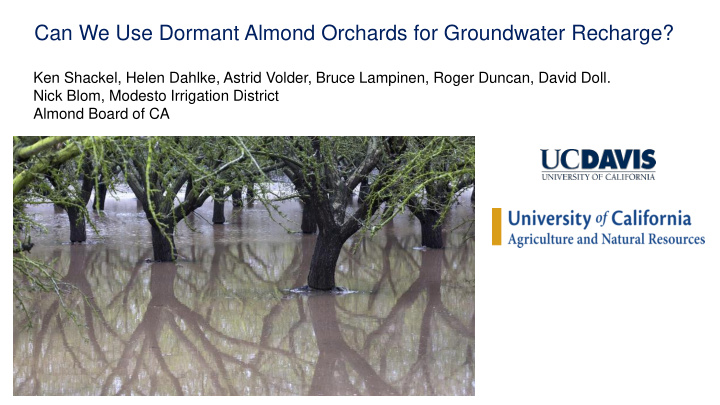



Can We Use Dormant Almond Orchards for Groundwater Recharge? Ken Shackel, Helen Dahlke, Astrid Volder, Bruce Lampinen, Roger Duncan, David Doll. Nick Blom, Modesto Irrigation District Almond Board of CA
Using Orchards for Winter Recharge Many ducks need to be in a row for winter recharge flooding to be a sustainable strategy in almonds Duck #1 (deal breaker): trees don’t die. Monitor: 1) Yield 2) Root & tree health 3) Tree water stress 4) Soil water Etc…. 5)
Saturated Soils: Generally BAD for Almonds
Saturated Soils: Generally BAD for Almonds Questions: 1. Is it OK for Almonds if the trees are dormant (Dec/Jan)? 2. What happens to root and tree health over the long run? 3. What about leaching of N, pesticides, salts, etc.?
“Moderately Good” SAGBI Modesto Two commercial orchard sites. Started trials in fall 2015 2015: Pre-treatment yields, install monitoring equipment “Excellent” SAGBI Winter 2015/16 & 2016/17: apply a total of 24” water during January Delhi 2016 & 2017: monitor tree health and yield
Modesto Recharge Site – Paradise Road – 15+ year old Flood-irrigated Nonpareil / Sonora / Monterey
Modesto Irrigation District Captured Storm Water Runoff
Six inches of water applied for four consecutive weeks in January
Compared against adjacent section with no winter irrigation
A suite of measurements: - water infiltration - Leaching of NO 3 , salts, etc. - Root growth, tree “stress”, bloom, growth, yield, etc.
Root zone hydrology – quickly drained in Delhi sand but root zone saturated for 48 hours in Modesto Site ~ 48 hrs ~ 6 hrs Fine sandy loam Sand
‘Mini -rhizotron ’ method to observe root growth and ‘health’
Standing Root Length Root growth Depth Delhi 6” • Trees in Recharge treatment showed higher standing root length: • Standing root length: rate of root 6” – 12” production minus rate of root death • Greater standing root length = longer root lifespan • Median lifespan of roots was about 12” – 18” 30-70% longer in the Recharge treatment than in the Control • Lifespan increased with depth except for 18- 24” depth 18” –24” • Greatest difference between Control and Recharge treatment at 6- 12” depth
Checking root health by testing for tree water stress: Are roots able to supply the water that the tree needs?
Testing for water stress during the growing season 0 (RECHARGE) -5 -10 Modesto (FSL) Fully Irrigated Baseline No evidence of water stress Control -15 resulting from impairment of root Recharge SWP (bar) water uptake. -20 0 (RECHARGE) -5 -10 Delhi (Sand) Fully Irrigated Baseline Some evidence of an improved Control -15 tree water condition with winter Recharge recharge irrigations. -20 JAN FEB MAR APR MAY JUN JUL AUG SEP Date, 2016
LIDAR GgPrR camera
Measuring PAR (Photosynthetically Active Radiation) = shade
Impact on Canopy Growth 2016 2017 Change No difference Control 72.0 a 65.3 a -6.7 Delhi in canopy growth in Recharge 75.8 a 65.4 a -10.4 recharge areas vs. control 2016 2017 Change Control 88.8 a 75.1 a -13.7 Stanislaus Recharge 85.2 a 77.2 a -8.0
Yield Data Year Treatment 2015 2016 2017 (pre-treatment) Modesto No Recharge 3360 3290 2980 Recharge 3430 3130 2990 Delhi No Recharge 1190 1140 2640 Recharge 1410 1200 3110 *Bottom line: no apparent negative effect on yield from winter flooding
Root zone hydrology
How much of applied water went to recharge? Summary of water inputs (rain & applied water) for October-March. Rain Applied Total deep Deep Deep Percolation Applied water Water percolation Percolation of applied water stored in from rainfall rootzone inches inches inches inches inches % inches % 12.94 26.15 29.09 4.79 24.30 93% 1.84 7% Delhi 2015/16 9.91 24.00 21.90 2.55 19.35 81% 4.65 19% Modesto 17.44 25.80 33.03 7.43 25.60 99% 0.20 1% Delhi 2016/17 12.46 24.00 27.94 4.78 23.16 96% 0.84 4% Modesto >80% of applied water went to deep percolation.. AWC = available water content
Soil Nitrate Delhi - Flood How much residual soil nitrate is leached during groundwater recharge events? • Soil cores (12 ft) were taken before November) and after(February) recharge events • Soil analysis: texture, pH, EC, soil nitrate, DOC • Nitrate and salts pushed deeper into soil profile
Modesto Soil Nitrate – Nov. vs Feb. - Modesto ROOT ZONE • Root zone (upper 3 ft): • 56% increase in Flood treatment • 220% increase in Control • Entire profile (12 ft): • 107% increase in Flood treatment Modesto • 20% increase in Control 12 ft PROFILE Most of the increase in soil nitrate in the root zone occurred is the result of nitrification Most of the increase of nitrate deeper in soil profile is a result of leaching Soil Nitrate: 1 kg/ha = 0.89 lb/acre
Conclusions • No obvious warning signs that winter irrigation (Dec/Jan) for groundwater recharge negatively affects trees • What about February / March?? • Trees on sandy sites might benefit from winter flooding • Sandy soils (Delhi) – clear nitrate loss from recharge • What about other leaching of other pollutants / pesticides? Regulations??
Recommend
More recommend